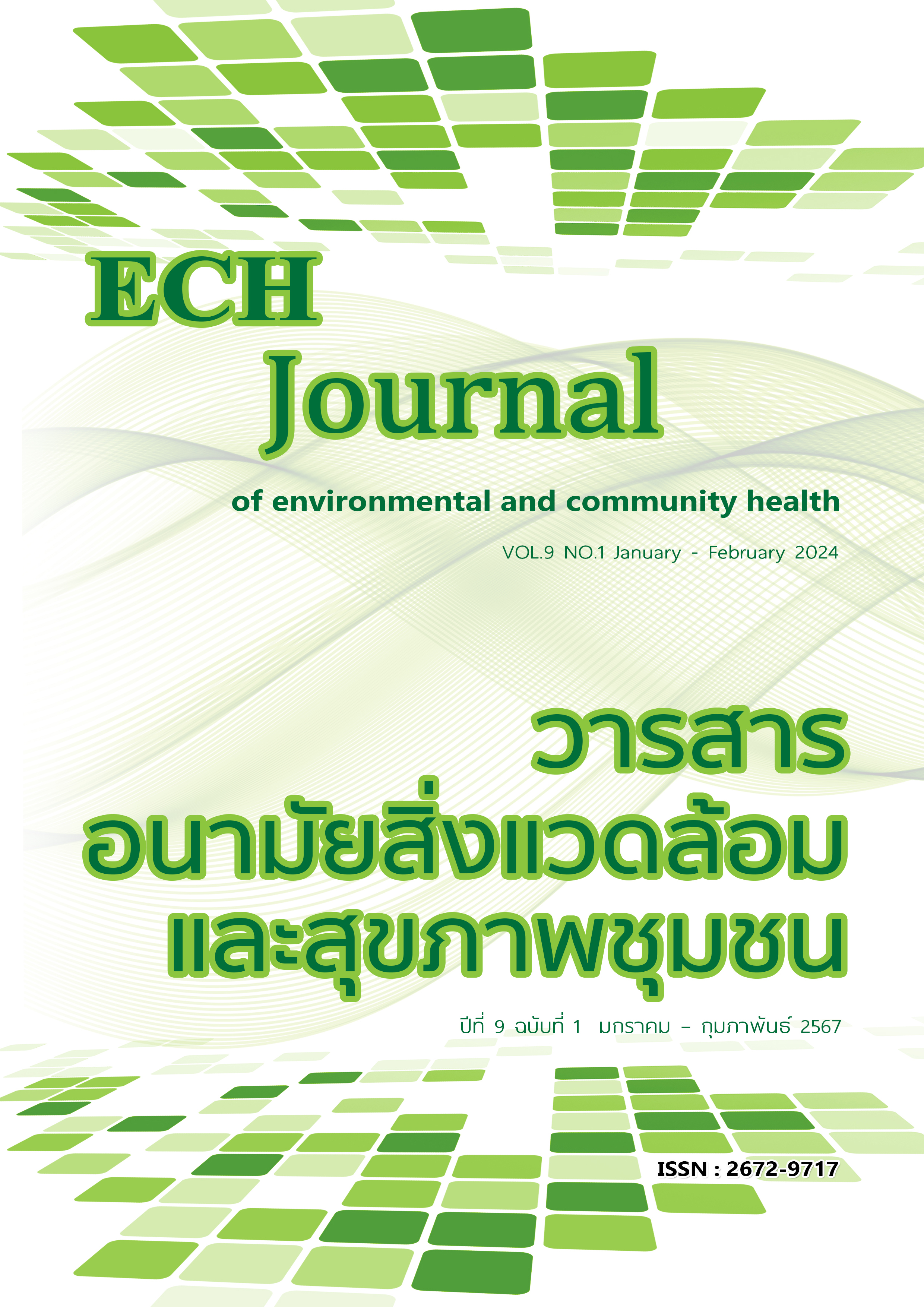ปัจจัยที่มีผลต่อการขาดนัดของผู้ป่วยความดันโลหิตสูงที่ได้รับการวินิจฉัยจากการคัดกรองกลุ่มเสี่ยงในชุมชน ในจังหวัดนครพนม
ความดันโลหิตสูง
คำสำคัญ:
การขาดนัด, ความดันโลหิตสูงบทคัดย่อ
การศึกษาวิจัยนี้เป็นการวิจัยเชิงสำรวจมีวัตถุประสงค์เพื่อศึกษาปัจจัยที่มีผลต่อการขาดนัดของผู้ป่วยความดันโลหิตสูงที่ได้รับการวินิจฉัยจากการคัดกรองกลุ่มเสี่ยงในชุมชนในจังหวัดนครพนม ประชากรได้แก่ ผู้ป่วยความดันโลหิตสูงที่ได้รับการวินิจฉัยจากการคัดกรองกลุ่มเสี่ยงในชุมชนกลุ่มศึกษาได้แก่ ผู้ป่วยความดันโลหิตสูงที่ไม่มาตามนัดหมาย ส่วนกลุ่มเปรียบเทียบได้แก่ ผู้ป่วยความดันโลหิตสูงมาตามนัดจับคู่โดยใช้สถานที่ ขนาดตัวอย่าง 112 คน ต่อกลุ่ม รวม 224 คน เก็บรวบรวมข้อมูลโดยใช้แบบสอบถาม มีความตรงตั้งแต่ 0.71 ขึ้นไป ความเที่ยง 0.8-0.9 วิเคราะห์ข้อมูลด้วยสถิติเชิงพรรณนาจำนวนและร้อยละค่าเฉลี่ยและส่วนเบี่ยงเบนมาตรฐาน วิเคราะห์ ความสัมพันธ์เบื้องต้นด้วยวิธีวิเคราะห์ถดถอยตัวแปรเชิงพหุแบบ Conditional logistic regression พร้อมประมาณค่าช่วงเชื่อมั่นร้อยละ 95 ที่ระดับนัยสำคัญที่ 0.05
ผลการวิจัย กลุ่มตัวอย่างส่วนใหญ่เป็นเพศหญิงร้อยละ 54.0 และ 70.0 ตามลำดับข้อมูลกระจายใน 11 อำเภอของจังหวัดนครพนม อายุระหว่าง 51-60 ปีมากที่สุด ผลการวิเคราะห์ถดถอยเชิงพหุแบบ Conditional logistic regression พบว่า การลืมนัดหรือไปทำธุระที่สำคัญกว่าเสี่ยงต่อการขาดนัด 488.0 เท่าของผู้เลือกที่จะมาตามนัดเมื่อถึงวันนัด รองลงมาได้แก่ การนัดวันนัดตรงกับนัดหมายอื่นหรือวันที่มีงานสำคัญมีความเสี่ยงต่อการขาดนัด 30.6 เท่าของผู้ที่นัดตรงกับวันว่าง ตัวแปรทั้งหมดสามารถทำนายขาดการรักษาตามนัดหมายในผู้ป่วยความดันโลหิตสูงจากการคัดกรองกลุ่มเสี่ยงในชุมชนในจังหวัดนครพนมได้ร้อยละ 79.6 ไม่มีข้อมูลเพียงพอในการอธิบายความสัมพันธ์ของตัวแปรอื่นๆ กับการขาดการรักษาตามนัดในผู้ป่วยความดันโลหิตสูงจากการคัดกรองกลุ่มเสี่ยงในชุมชนในจังหวัดนครพนม
เอกสารอ้างอิง
World Health Organization. Hypertension [Internet]. 2022 [cited 2022 Jan 12]. Available from: https://www.who.int/health-topics/hypertension#tab=tab_1
World Health Organization. Cardiovascular diseases (CVDs) [Internet]. 2017 [cited 2565 Mar 22]. Available from: https://www.who.int/news-room/fact-sheets/detail/cardiovascular-diseases-(cvds)
Chobanian AV, Bakris GL, Black HR, et al. The seventh report of the Joint National Committee on Prevention, Detection, Evaluation, and Treatment of High Blood Pressure:the JNC 7 report. JAMA. 2003;289(19):2560–72.
Go, A.S., Bauman, M.A., Coleman K.M., et al. An effective approach to high blood pressure control: a science advisory from the American Heart Association, the American College of Cardiology, and the Centers for Disease Control and Prevention. Hypertension. 2014;63:878–85.
Fuster, V., Harrington, R.A., Narula, J. & Eapen, Z.J. The Heart. 14th ed. NY: McGRaw-Hill; 2017.
อรรถเกียรติ กาญจนพิบูลวงศ์, ภาณุวัฒน์ คำวังสง่าและ สุธิดา แก้วทา. รายงานสถานการณ์โรค NCDs เบาหวาน ความดันโลหิตสูงและปัจจัยเสี่ยงที่เกี่ยวข้อง พ.ศ.2562. นนทบุรี: อักษรกราฟฟิคแอนด์ดีไซด์; 2563.
CHRONICFU. รายงานผู้ป่วยความดันโลหิต พ.ศ.2563 [Internet]. 2563. Available from: https://spo.moph.go.th/audit50/images/43f_structr/CHRONICFU.pdf
Booth III, J.N., Jiexiang L., Zhang,L. ,Chen, L. & et al. Trends in Prehypertension and Hypertension Risk Factors in US Adults. Hypertension. 2017;70:275–84.
Maimaris,W., Paty,J., Perel,P, Legido-Quigley, H. & et al. The Influence of Health Systems on Hypertension Awareness, Treatment, and Control: A Systematic Literature Review. PLoS Med. 2013;10(7):e1001490.
สำนักโรคไม่ติดต่อ กรมควบคุมโรค กระทรวงสาธารณสุข. รายงานประจำปี 2563. นนทบุรี: สำนักพิมพ์อักษรกราฟฟิคแอนด์ดีไซน; 2563.
Uchmanowicz, B., Chudiak, A. & Mazur, G. The influence of quality of life on the level of adherence to therapeutic recommendations among elderly hypertensive patients. Patient Prefer Adherence. 2018;12:2593–603.
Chimberengwa, P.T. & Naidoo, M.N. Knowledge, attitudes and practices related to hypertension among residents of a disadvantaged rural community in southern Zimbabwe. Plos One. 2019;14(6):e0215500.
Klinis, S., Tsimtsiou, Z., Makaki, A.A., Galanakis, C., & et al. Patients’ Beliefs and Attitudes Towards Hypertension and its Treatment: a Rural Practice Pilot Study. ROM J Intern Med. 2014;52:27–9.
Villarino, R.T., Arcay, C.A., Temblor, M.C., Vilarino, L. & et al. The Effects of Lifestyle Intervention Using the Modified Beliefs, Attitude, Subjective Norms, Enabling Factors Model in Hypertension Management: Quasi-Experimental Study. JMIR Cardio. 2021;5(2):e20297.
Osamor, P.E. Social support and management of hypertension in south-west Nigeria. Cariovascular J Afr. 2015;26(1):29–33.
Marin-Reyes, F. & Rodriguez-Moran, M. Family support of treatment compliance in essential arterial hypertension. Salud Publica Mex. 2001;43:336–9.
Pan, J., Hu, B., Wu, L. & Li, Y. The Effect of Social Support on Treatment Adherence in Hypertension in China. Atient Prefer Adherence. 2021;15:1953–61.
Li, T. & Li,, Y. Analysis on the willingness and influencing factors of choosing primary healthcare institutions among patients with chronic conditions in China: a cross-sectional study. BMC Open. 2022;12:E054783.
กองยุทธศาสตร์และแผนงาน กระทรวงสาธารณสุข. รายละเอียด ตัวชี้วัดกระทรวงสาธารณสุข ประจําประจำปีงบประมาณ พ.ศ. 2565. รายละเอียด ตัวชี้วัดกระทรวงสาธารณสุข ประจําประจำปีงบประมาณ พ.ศ. 2565 [Internet]. 2565 [cited 2022 Jan 12]. Available from: ตัวชี้วัดกระทรวงสาธารณสุขhttps://phdb.moph.go.th › upload › web_news_filesPDF
HDC. รายงานผลการตรวจคัดกรองโรคความดันโลหิตสูงในชุมชน [Internet]. 2565 [cited 2022 Mar 22]. Available from: http://hdc.ntwo.moph.go.th/hdc/main/index.php
Dupont, W.D. Power calculations for macthed case-control studies. Biometrics. 1998;52(44):1557–68.
Schlesselman, J. Case-control studies design, conduct, analysis. New York. NY: Oxford University Press; 1982.
Nwabuo, C.C, Dy, S.M., Weeks, K. & Young, H. Factors Associated with Appointment Non-Adherence among African-Americans with Severe, Poorly Controlled Hypertension. Plos One. 2014;9(8)::e103090.
Ashoorkhani, M.A., Majdzadeh, R., Gholami, J., Eftekha, H. & Bozorgi, A. Understanding Non-Adherence to Treatment in Hypertension: A Qualitative Study. IJCBNM. 2018;6(4):314–23.
Ajzen, I. The theory of planned behavior. Organ Behav Hum Decis. 1991;(50):179–211.
Pan, D., He, M., & Kong, F. Risk attitude, risk perception, and farmers’ pesticide application behavior in China: A moderation and mediation model. J Clean Prod. 2020;276(124241).
Pender, N.J., Murdaugh, C.L. & Parsons, M.A. Health Promotion in Nursing Practice. 6th ed. New Jersey: Pearson; 2015.
Bandura, A. Self-efficacy: Toward a unifying theory of behavioral change. Psychol Rev. 1997;84(2):191–215.
Rosenstock, I.M., Strecher, V.J. & Becker, M.H.. Social Learning Theory and the Health Belief Model. Heal Educ Behav. 1998;15(2):175–83.
Joho, A.A. Using the Health Belief Model to Explain the Patient’s Compliance to Anti-hypertensive Treatment in Three District Hospitals - Dar Es Salaam, Tanzania: A Cross Section Study. East Afr Health Res J. 2021;5(1):50–8.
Zhou, C., Chen, J., Tan, F., Lai, S. & et al. Relationshipbetweenself-care compliance,trust,andsatisfaction amonghypertensivepatientsin China. Front Public Health. 2022;10(1085047):1–9.
น้ำทิพย์ สงวนบุญญพงษ์และสายใจ พัวพันธ์. ปัจจัยที่สัมพันธ์กับการขาดนัดการรักษาของผู้ป่วยโรคจิตเภทที่เข้ารับการรักษาในโรงพยาบาลชุมชน จังหวัดฉะเชิงเทรา. วารสารพยาบาลทหารบก. 2560;18(1):229–36.
Najimi,A. Mostafavi,F., Sharifirad, G. & Golshiri, P. Barriers to medication adherence in patients with hypertension. J Educ Health Promot. 2018;7:24–31.
Jimmy, B.& Jose, J. Patient Medication Adherence: Measures in Daily Practice. Oman Med J. 2011;26(3):155–9.
Haynes RB, Devereaux PJ, Guyatt GH. Physicians’ and patients’ choices in evidence based practice. BMJ. 2002;324(7350):1350.
Haynes RB, McKibbon KA, Kanani R. Systematic review of randomised trials of interventions to assist patients to follow prescriptions for medications. Lancet. 1996;348(9024):383–6.
Leupkar, RV. Patient adherence: A “risk factor” for cardiovascular disease: The Framington Study. JAMA. 1971;215:1617-25.
Watson, B., Tunnicliff, D., White, C., Schonfeld, C. & Wishart, D. Psychological and Social Factors Influencing Motorcycle Rider Intentions and Behavior. Canberra: Transport Safety Bureau of Research and Analysis Road Safety; 2007.
Triandis, H.C. alues, attitudes, and interpersonal behavior. Nebr Symp Motiv. 1980;27:195–259.
Leupkar, R.V. Patient adherence: A “risk factor” for cardiovascular disease. JAMA. 1971;215:1617–25.
Tarn DM, Heritage J, Paterniti DA, Hays RD, Kravitz RL, Wenger NS. Physician communication when prescribing new medications. Arch Intern Med. 2006;199(17):1855–62.
Ha, J.H. Doctor-Patient Communication: Rev. 2010;10(1):38–43.
Brédart A., Bouleuc C., Dolbeault S. Doctor-patient communication and satisfaction with care in oncology. Curr Opin Oncol. 2005;17(14):351–4.





